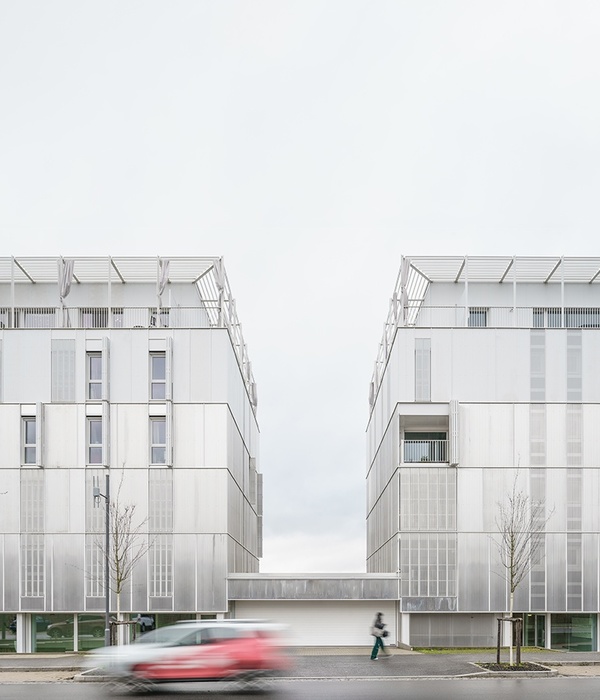Architect:IOSA GHINI ASSOCIATI SRL
Location:Bologna, Italy; | ;View Map
Project Year:2019
Category:Airports;Bridges;Passenger Terminals
The Marconi Express designed for the city of Bologna is a transport system that is innovative in terms of technology, the regulation of circulation and architectural features.The infrastructure, with a total length of 5084 metres, is composed of a monorail, with two terminals – at the airport and the train station – and the intermediate stop of Lazzaretto, about halfway along the route, where the cars cross. The stop includes the depot and workshop, as well as the centralized control station. The stops and the bridge over the ring-road/motorway system were designed based on a type of architecture that takes into account the need to connect an infrastructure to an urban fabric that will undergo major redevelopment work, but that is partially absorbed by the outlying countryside.
Its stops are set in different contexts in terms of both architectural structure and urban fabric. The stops are connected to each other via a route with a walkway running along the track, serving as a passenger escape route in case of emergency. The project emerges as an opportunity to create a long and environmentally friendly ‘belt’ with photovoltaic panels and green areas. Its design and form permit the installation of photovoltaic panels on the southwest side, thus maximizing energy performance, whereas to the north glazed panels serve as balustrades to give the entire line a sense of transparency and lightness. The architecture of the route and the individual stops meshes with the urban setting, using elements that create transparency and lightness, and conveying the idea of motion while also taking up traditional forms.
The stations are an excellent example, as they fit into the landscape beautifully, taking up the architectural forms and lines of the rural architecture of the plains. The perforated steel envelope makes it possible to perceive and glimpse the support structure (composed of custom-made metal ribs), giving it a sense of lightness that would have been impossible with a solid material. The slope of the station roofing is designed to accommodate photovoltaic panels, particularly at the Lazzaretto station, exploiting the southwest exposure of the pitches. The stations have been sized with an eye to doubling the Marconi Express line in the future.
The route that connects the station is underscored by a series of piers that support all the tracks and the individual stops. The piers mark a route that blends into the landscape between the train station and the airport. Emulating the route that connects the sanctuary of San Luca to the city, the line takes up a form that evokes Bologna’s famous porticoes, updating their appearance and the concept of support, but without forgetting the city’s traditional architecture.
For the different heights and sizes of the piers, the architectural section is uniform up to a height of 7 metres, at which point it widens and incorporates the walkway. In other cases, with heights of up to 25 metres, a variable pier section of the pier was employed – widening like a slender tree trunk that is rooted solidly in the ground – in order give the structure of the entire route a more lightweight appearance.
The study of the motorway/ring-road overpass was another important project aspect. The details of the bridge (dubbed “the Link”) and its structural elements rely on natural and simple forms, creating an architecture that marks the entrance to the city of Bologna. The design of the bridge addresses a combination of technical and perceptual-visual requirements. The technical aspect involved solving the problem of the height difference with respect to the rest of the route, which uses a monorail, as the 100-metre-long bridge has two beams so that the line can be doubled in the future. Secondly, on a visual level the bridge will serve an architectural element and point of reference for the traveller as part of the motorway landscape, conveying the idea of motion.
These two problems were solved by designing two portals whose form and fluid size are extraordinary devices concealing the height difference and serving as the connection point for the monorail and a double-track bridge. The outcome is an elegant figure that gives a rapid route – that of the Marconi Express – a distinctive identity even from a distance. The two portals distinguish one’s arrival in Bologna, just as the city gates mark the entrances to the medieval centre.
1. Iosa Ghini Associati: Concept And Architectural Project
2. MATE Soc.Coop.va-STS SpA: General Project Coordination
3. Studio Bruni- Gandolfi: Station Structures And Viaduct Understructures
4. Studio Matildi + Partners: Metal Structures
5. Intamin e Inautec: Transport Technology
6. Steer: Traffic Study
7. Consorzio INTEGRA: General Contractor
8. People Mover Bologna S.c.a.r.l. with coops: CMSA, Clea, TM, Unifica: Execution
9. LMV: Metal Works Execution
▼项目更多图片
{{item.text_origin}}












